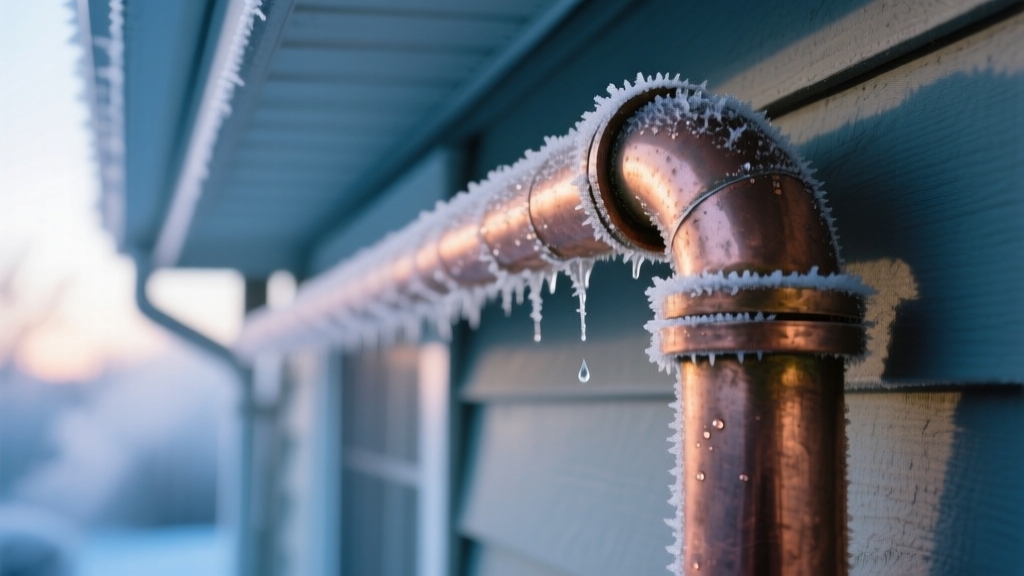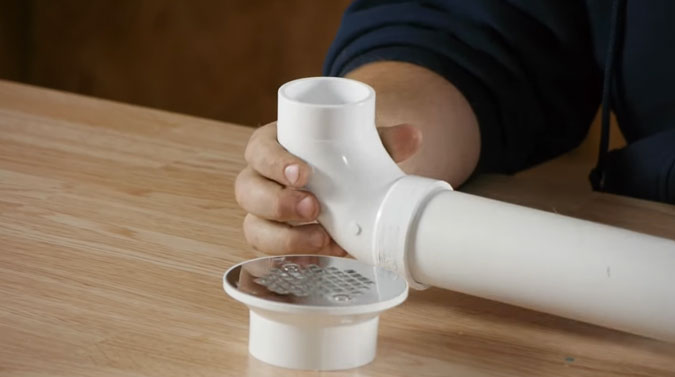If your pipe is uninsulated and exposed to temperatures below 20°F, it can start freezing within just two to six hours.
Metal pipes freeze faster due to better heat conduction, while insulated or plastic pipes take longer, often only freezing below 20°F with prolonged exposure.
Factors like pipe material, diameter, location, and insulation quality also affect freeze times. Understanding these details helps you protect your plumbing and prevent costly damage from bursting pipes. Keep exploring to learn how to safeguard your system effectively.
Key Takeaways
- Pipes can start freezing within 2 to 6 hours when exposed to temperatures at or below 20°F (-6.6°C).
- Uninsulated metal pipes in unheated areas freeze faster than insulated or plastic pipes.
- Smaller diameter pipes freeze more quickly due to reduced water volume and increased heat loss.
- Standing water inside pipes freezes quicker, while flowing water delays freezing significantly.
- Proper insulation and sealing gaps can delay pipe freezing well below typical outdoor temperatures.
Factors Affecting Pipe Freezing Time
When you consider how long it takes for a pipe to freeze, several key factors come into play that directly influence the freeze time and risk of damage.
Pipe material affects thermal conductivity; metal pipes freeze faster due to higher heat transfer. Plastic pipes freeze slower but tolerate less burst pressure once frozen. Regular maintenance is essential to prevent mineral scale buildup that can affect pipe integrity.
Pipe diameter and wall thickness matter too; smaller diameters and thinner walls accelerate freezing by reducing water volume and increasing heat loss.
Location plays a role: pipes in unheated, exposed areas freeze rapidly, especially if against exterior walls or outdoors. Vulnerable areas include unheated spaces and exterior walls, which are more prone to freezing. Insulation quality and coverage are critical; gaps create cold spots that induce freezing, while good insulation delays it.
Finally, water conditions matter; standing water freezes faster, so maintaining flow helps prevent ice plug formation and reduces freezing risk. Voltage fluctuations impacting pump performance can indirectly affect water flow and thus freezing risk in pipes.
Temperature Thresholds for Freezing Pipes
Although water freezes at 32°F (0°C), the temperature at which pipes begin to freeze varies based on insulation, exposure, and location.
Water freezes at 32°F, but pipe freezing depends on insulation, exposure, and location.
Pipes can start freezing at or just below 32°F, but insulated pipes generally freeze around 20°F (-6.6°C).
Uninsulated pipes in unheated spaces, like basements or exterior walls, may freeze even above 20°F if exposed to drafts or cold air.
Outdoor air temperature doesn’t always reflect pipe temperature; localized cold spots increase risk.
Prolonged exposure below 20°F drastically raises freezing and bursting chances.
Pipes often freeze within 6 hours at or below 20°F, sometimes faster if uninsulated.
You should monitor temperatures carefully, especially during sustained freezes, to prevent damage.
Rapid temperature drops in vulnerable areas accelerate freezing and increase burst risk. Sustained cold is more likely to cause pipe damage than brief cold snaps.
Role of Insulation in Delaying Pipe Freezing
Understanding how insulation impacts the freezing process is key to extending the time it takes for pipes to freeze under cold conditions.
Insulation materials like foam, rubber, and fiberglass reduce heat transfer, slowing pipe temperature drop. Choosing the right insulation material based on environment and pipe location enhances protection.
Foam pipe insulation offers a snug, cost-effective barrier, while rubber provides moisture resistance and flexibility.
Fiberglass suits high-temperature pipes but demands proper sealing to block cold air.
Heat tapes supply continuous low-level warmth, critical in unheated spaces.
To maximize effectiveness, you must measure pipes accurately, cut insulation to fit completely, and secure it with tape or zip ties.
Sealing all gaps prevents cold air intrusion. Proper insulation not only delays freezing but also maintains thermal efficiency, reduces condensation, and protects pipes from corrosion and mold.
This ensures long-term pipe integrity and energy savings. Additionally, insulating pipes helps prevent freezing and bursting, which protects your plumbing system from damage during subfreezing temperatures.
Environmental Influences on Pipe Freeze Rates
Since pipe freezing depends heavily on environmental factors, you need to take into account temperature thresholds, ambient conditions, pipe materials, location, and water movement to accurately assess freeze risks.
Water freezes at 32°F (0°C), with risks rising sharply below 20°F (-6°C), especially when wind chill accelerates heat loss. Pipes in unheated spaces or along exterior walls freeze faster due to cold air exposure.
Freeze risks increase below 20°F, especially with wind chill and exposure in unheated or exterior wall areas.
Metal pipes conduct heat quickly, freezing sooner than plastic, which can better tolerate ice expansion. Stagnant water freezes rapidly; even slight flow delays freezing. Adjusting the water pressure regulator can help maintain flow and reduce freeze risks.
Buried pipes face soil temperature impacts, while drafts and cold air infiltration create localized freeze points. Freezing can occur in as little as 2 to 6 hours under extreme cold. Understanding these variables lets you predict freeze timing and prioritize preventive measures effectively.
Risks Associated With Frozen Pipes
When pipes freeze, you immediately face the risk of water supply disruption, halting all essential household and business functions that rely on running water.
Frozen pipes block water flow, making cooking, cleaning, and hygiene impossible and increasing health risks during cold weather. Letting faucets drip during cold snaps can help prevent the pipes from freezing by keeping water moving and reducing ice buildup prevention method. Properly maintaining and inspecting your plumbing system can reduce the likelihood of freezing and damage.
The ice expansion can cause pipes to crack or burst, leading to leaks that may release hundreds of gallons daily, resulting in extensive water damage to structural components and belongings.
Repairs are costly, averaging around $27,000 per claim, with potential insurance complications and out-of-pocket expenses. Additionally, water damage promotes mold growth and structural weakening, posing health and safety hazards.
Pipes in unheated areas are most vulnerable, so proactive insulation and winterizing are vital to minimize these risks and avoid prolonged disruptions or expensive repairs. Understanding the components of water systems can help in effective winterization.
Frequently Asked Questions
Can Pipes Freeze if the Water Is Flowing Slowly?
You might think flowing water is a shield against freezing, but pipes can still freeze if the flow is too slow.
When water moves sluggishly, it loses heat to the cold environment, making it as vulnerable as standing water.
To truly prevent freezing, you need a steady trickle that maintains enough heat transfer.
Otherwise, even slow-moving water can become an icy trap in harsh temperatures.
What Are the Best Materials to Prevent Pipe Freezing?
You should use foam rubber sleeves or polyethylene pipe insulation for effective, moisture-resistant coverage.
Fiberglass offers excellent thermal resistance but requires careful handling.
Self-sealing insulation simplifies installation with adhesive strips, reducing heat loss.
For extreme cold, combine these with electric heating cables or heat tape, which provide controllable warmth.
Remember to insulate the entire pipe length in vulnerable areas and seal gaps to maximize protection against freezing.
How Can I Safely Thaw a Frozen Pipe?
Thawing a frozen pipe is like unwrapping a delicate gift. You need patience and care.
Start by opening faucets to relieve pressure and identify the cold spot on the pipe.
Use a hairdryer or heat lamp to warm the pipe gradually, moving heat from the faucet end toward the freeze.
Avoid open flames.
If you suspect damage, shut off water immediately.
Keep safety in mind, monitor progress, and call a plumber if unsure or if leaks appear.
Does Salt or Antifreeze in the Water Prevent Freezing?
Salt or antifreeze in household water pipes won’t effectively prevent freezing and pose significant risks.
Saltwater corrodes pipes and affects taste, while antifreeze is toxic and prohibited in potable systems.
Instead, focus on insulation, heating methods, or keeping water moving to protect your pipes safely.
Using chemicals in home plumbing isn’t practical or code-compliant, so avoid them to maintain system integrity and ensure safety.
Are Outdoor Hoses at Higher Risk of Freezing Than Indoor Pipes?
You might think outdoor hoses freeze faster than the Arctic itself!
Yes, outdoor hoses face a much higher risk of freezing compared to indoor pipes because they’re directly exposed to colder ambient temperatures and often lack insulation.
Indoor pipes usually benefit from warmer surroundings and protective structures.
To protect your outdoor hoses, use frost-free spigots, disconnect hoses during winter, and insulate exposed pipes to minimize freezing risks effectively.
Stay Ahead of the Freeze: Protect Your Pipes Before It’s Too Late
You can’t control the weather, but you can arm yourself with knowledge to outsmart freezing pipes. When temperatures dip below 20°F, water inside your pipes begins its icy siege, with freezing times shrinking like shadows at dusk.
Insulation acts as your fortress, delaying the chill’s advance. Remember, every degree counts, and every preventive step you take is a shield against costly bursts. Stay vigilant; time and temperature dictate your pipes’ fate.


